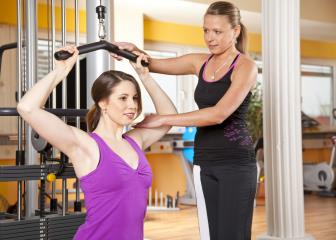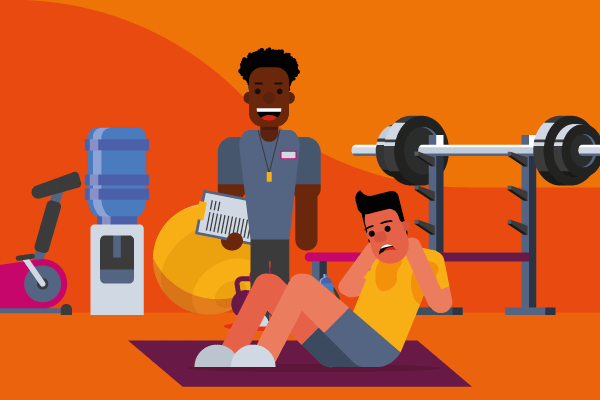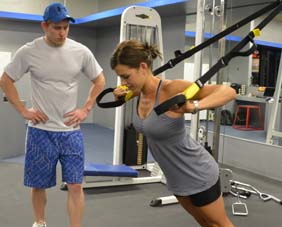
Here are some tips if you're thinking of hiring a personal coach. First, make sure to establish your expectations. Have a conversation with your trainer. Ask them about your fitness goals, history, injuries, and any deficiencies you may have. You should also make clear expectations of the trainer. Also, you should consider hiring a coach with a track record. You should speak with at least three trainers before making a decision.
Personal trainer
The best way to gain work experience in the fitness industry is to become certified as a personal trainer. Although you don’t need to be a college graduate to become a personal trainer or coach, most universities have courses that will help you in the field. A university degree is expensive. However, even if it's not possible to afford college, you can still become an instructor.
Not only do personal trainers have a vast knowledge of exercise techniques and exercise equipment, they also have experience in different types of fitness needs. To prevent further damage to the cartilage, clients with diabetes may need a restraining of high-impact exercises. Clients with arthritis, for example, will need strength training techniques as well as joint stability exercises. No matter your needs, a personal trainer can help.
Selecting a personal trainer
A few things to keep in mind when looking for a personal trainee. First, consider the fit of the trainer with your lifestyle. For another, it's important to choose someone who is qualified and registered. A personal trainer will not only create the perfect workout program for you, but can also provide nutritional advice to ensure that your results are optimal.

The next thing to look for when choosing a personal trainer is whether or not the trainer is available on the days you need them. Some trainers work late or early in the morning, while others only work weekends. You should also ask questions. Ask questions if a trainer seems hesitant to answer your questions. It is not a good idea to have a trainer who is not interested in your goals or doesn't take your concerns into consideration.
Choosing a trainer with proven experience
While credentials are important in choosing a personal training professional, they are not the most important. Clients value the trainer's passion and knowledge more than their credentials. You might choose a personal trainer who is a skilled and experienced trainer with a passion for the subject. If this is the case, it's worth looking for a trainer who has been certified by a national association or has lots of experience.
Credentials are just the first step. You should ensure that the trainer you choose has had experience in training people with similar goals. You should verify that they are familiar with the types of workouts you're interested in and if they have any experience with them. While credentials can be helpful, ask about the testimonials of their clients. The more clients they have taught, the greater.
Finding a trainer with proven track record
There are many things you should take into consideration when hiring a personal training professional. You should not judge them by their client list; even though they may have a few big names, their client list does not necessarily indicate their success rate. It is possible for a trainer to have just a few failed clients. References are perhaps the most important thing to look for when hiring a personal trainer. Referrals can be the endorsements of others who have worked with a personal trainer.

Before you hire a personal training professional, it is important to consider your goals. Are you looking for basic or motivational exercise guidance? Are you interested in learning how to run the marathon? If so, look for a trainer who specializes in that specific field. Remember that a trainer who runs marathons is not necessarily an expert in deadlifts. Ask them about their experience in working with people in your situation. Ask them about their training experience and why they chose that trainer.
FAQ
What does butter do for men?
Butter is a great source of saturated fats. This type fat is great for your skin and hair. It also helps you build stronger bones.
Vitamin K in butter also prevents bleeding from cuts, bruises and other injuries. Vitamin K and vitamin B work together to prevent any bruising.
Butter is also rich with minerals, such as calcium and phosphorous. These elements help to build stronger bones and teeth.
Butter is not without its flaws. Butter contains high amounts of cholesterol. Studies show that too much cholesterol can increase your risk of developing heart disease.
Butter is high in saturatedfat, which contributes both to obesity, and raises cholesterol.
Butter can be spread on bread, but you don't have to dip it into soups or salads if you absolutely must. Bread absorbs less oil than pasta and potatoes.
Eggs good for men
The egg has all the nutrients the body requires. It is also good for maintaining strong bones, healthy heart and lungs, as well as stable blood pressure.
Eggs are an excellent source of protein, vitamins A, B12, D, E, K, calcium, phosphorus, iron, zinc, copper, magnesium, selenium, and riboflavin.
Egg yolks are high in cholesterol. However, the egg yolk is low in cholesterol. Eggs are low in saturated fat compared to other foods.
In addition, they are low in sodium and calories. You can make them in any way you like. You can cook them in many ways, including poaching, boiling, hard-boiling, baking, and scramble.
They are extremely nutritious and simple to prepare.
Aim to eat two whole eggs per week. You don't have to eat eggs.
Eggs are a good source of essential nutrients for our bodies. Add eggs to your diet today.
What is a good gym routine for you?
To stay fit, you need to exercise regularly. You don't have to do the same type of exercise every day, it doesn't really matter. Consistency is key. If you want to achieve results, you must stick at it for an extended period.
Start by doing small amounts of daily physical activity (like walking). Start by walking for a few minutes every day. Gradually increase your time exercising to 30 minutes per week. You can choose to run, swim, weight train, do yoga or take aerobics classes.
It's important that you get your exercise done every day. If you have a reason to miss a session, don't skim it.
Wear appropriate clothing and footwear when exercising outdoors. You also need to consider the weather conditions and whether they affect your ability to exercise safely.
When you exercise, make sure you are drinking plenty of water. It is best to avoid alcohol while you're exercising. Avoid caffeine-rich drinks like coffee, tea, and coca. They can provide energy, but they also dehydrate.
You might feel tired when you start to exercise for the first time. But if your workouts are continued, you will feel more energetic.
Do I have the obligation to exercise every day or just on occasion?
No! You should do at least 30 mins of moderate-intensity activity 5 days per week. That means walking fast enough to be slightly out of breath or biking hard enough to sweat.
Is Cardio Better Than Strength Training?
Both are equally good. But cardio is a much better choice if you want to gain muscles faster.
Cardio burns more calories per minute than strength training and burns more fat.
Strength training builds muscle mass, but it takes longer to achieve this goal than cardio.
What is your favorite workout order?
It depends on what you are looking for. You should start with heavy weights if your goal is to build muscle mass. Then move into cardio. If you are looking to lose weight, then move on to strength training.
If you just want to burn fat, start by doing cardio. Next, add strength training.
You should do cardio last if your goal is to increase muscle mass. This stimulates growthhormones, which helps build muscle mass.
Before you start your workout, it is a good idea to eat. This will give your muscles more fuel, so they work harder. This will make you feel better while working out.
What does the milk do for men
Think about other uses for milk next time you purchase it. You might also find it helpful to stop drinking coffee.
The benefits of milk have been demonstrated to be both beneficial to children and adults. Milk provides children with nutrients such as vitamin D, calcium, potassium, phosphorous, and magnesium.
It also aids digestion, improves bone strength, and promotes weight gain. The immune system is stronger and there are fewer illnesses in adults who consume dairy products.
The lactose in milk is also high, so people with digestive problems can enjoy the benefits of milk without experiencing stomach discomfort.
Consider drinking more milk, instead of sodas or juices. You can strengthen your teeth with the extra calcium and vitaminD found in milk.
Plain low-fat yogurt is another option if milk tastes bland to you. Yogurt is an excellent alternative to milk because it is lower in calories, and contains more protein.
Yogurt also contains probiotics, which aid in digestion and improve immunity.
A glass of warm milk is a great way to get a good night's sleep if you're having trouble getting to sleep. Warm milk relaxes muscles and increases serotonin levels, helping you get a good night's rest.
Statistics
- An estimated calorie range for moderately active adult males falls between 2,200 to 2,800 calories per day, depending on age. (eatright.org)
- According to the American Academy of Dermatology (AAD), men over 50 are at a heightened risk of developing it. (healthline.com)
- Candidates and applicants must pass all four tests at 70% (minimum level) to graduate from Basic Deputy U.S. Marshal (BDUSM) Training. (usmarshals.gov)
- Cardmembers earn 5% Back at Amazon.com with a Prime Credit Card. (amazon.com)
- Get free shipping and 25% off today. (healthline.com)
External Links
How To
How can a man get fit in 30 days?
Breaking down your fitness goals into manageable steps is the best way to reach your goals.
You need to make sure you are working towards the goal each day. This could mean anything from doing 10 pushups for 5 minutes to running 3km.
If you do this consistently over time, you will see positive results.
Here, consistency is the key. You must keep going until you succeed.
What is the difference between Aerobic Fitness and Anaerobic Fitness?
Anaerobic fitness means that our bodies can perform intense physical work with no oxygen. Anaerobic pathways are used to give our bodies enough energy to perform high-intensity exercise. Anaerobic pathways include glycolysis and creatine phosphate.
Cardio fitness is, in contrast to aerobic fitness, the practice of sustaining low-intensity exercise. When doing aerobic exercises, oxygen serves as the primary source for fuel for the cells. In other terms, the aerobic pathway has more energy that the anaerobic.
For example, if you want to run a marathon, you must first build up your aerobic capacity. If you only focus on building up your anaerobic capacity, you won't be able to finish the race.
Aerobic fitness also refers to cardiovascular fitness. The two most commonly used methods of measuring cardiovascular fitness, are VO2 Max testing and step tests.
VO2 Max Testing
The maximum amount of oxygen (O2) the body can use during exercise is called VO2 max. This test measures the amount of O2 the body can utilize while exercising.
This test measures cardiovascular fitness in a way that is most accurate. The test is difficult to administer because it requires expensive equipment.
Step Tests
Step tests are an easy but powerful way to determine your cardiovascular fitness. You will be asked to walk, jog or run for a specific time on a track. This is based on your age or weight.
These tests are inexpensive, easy to conduct, and can be done almost anywhere. For instance, you can walk on a treadmill for 2 minutes, rest for 1 minute, repeat this process for 20 minutes, and then stop. Your heart rate should remain within a specific range throughout the whole session.
This protocol is called the "Bruce Protocol". Bruce, himself a runner developed this protocol when he realized his heart rate didn't rise when he ran long distances.